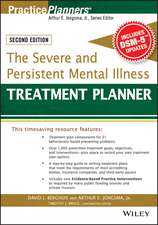Best Practices in Prevention: Prevention Practice Kit
Editat de Sally M. Hage, John L. Romanoen Limba Engleză Paperback – 11 feb 2013
Preț: 300.69 lei
Preț vechi: 316.51 lei
-5% Nou
Puncte Express: 451
Preț estimativ în valută:
57.56€ • 62.54$ • 48.38£
57.56€ • 62.54$ • 48.38£
Carte tipărită la comandă
Livrare economică 21 aprilie-05 mai
Preluare comenzi: 021 569.72.76
Specificații
ISBN-13: 9781452257976
ISBN-10: 1452257973
Pagini: 72
Dimensiuni: 178 x 254 x 8 mm
Greutate: 0.14 kg
Ediția:New.
Editura: SAGE Publications
Colecția Sage Publications, Inc
Seria Prevention Practice Kit
Locul publicării:Thousand Oaks, United States
ISBN-10: 1452257973
Pagini: 72
Dimensiuni: 178 x 254 x 8 mm
Greutate: 0.14 kg
Ediția:New.
Editura: SAGE Publications
Colecția Sage Publications, Inc
Seria Prevention Practice Kit
Locul publicării:Thousand Oaks, United States
Cuprins
Chapter 1. Why Practice Prevention? Why now? - Sally Hage, John Romano
Chapter 2. Four Theories and Perspectives to Support Prevention Interventions
Chapter 3. Guidelines for Prevention Practice, Research, Education, and Public Policy
Chapter 4. Research Informed Prevention Practice: Learning from the Wisdom of Science
Chapter 5. Empirically Supported Prevention Applications
Chapter 6. Ethical and Professional Issues in Prevention
Chapter 7. Applying Prevention Learning: Five Learning Exercises
Chapter 2. Four Theories and Perspectives to Support Prevention Interventions
Chapter 3. Guidelines for Prevention Practice, Research, Education, and Public Policy
Chapter 4. Research Informed Prevention Practice: Learning from the Wisdom of Science
Chapter 5. Empirically Supported Prevention Applications
Chapter 6. Ethical and Professional Issues in Prevention
Chapter 7. Applying Prevention Learning: Five Learning Exercises
Descriere
This second book in the Prevention Practice Kit provides counselors, psychologists, and other mental health workers with practical steps that need to be considered by prevention practitioners as they engage with others in developing and delivering prevention projects. A context for engaging in prevention practice is provided, including discussion of how prevention fits with traditional models of psychology, descriptions of theoretical models for doing prevention practice, and examples of empirically-supported prevention interventions.
























